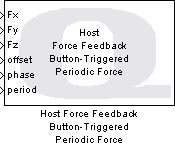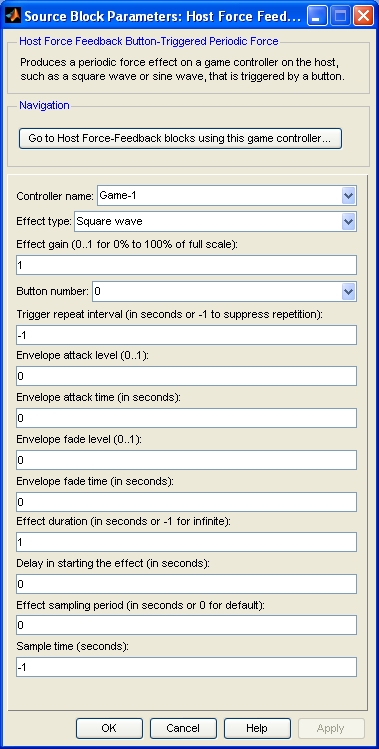

Host Force Feedback Button-Triggered Periodic Force
Produces a periodic force effect on a game controller on the host that is triggered by a button.
Library
QUARC Targets/Devices/Peripherals/Host/Force Feedback Game Controllers/Periodic Force Effects MATLAB Command Line Click to copy the following command line to the clipboard. Then paste it in the MATLAB Command Window: qc_open_library('quarc_library/Devices/Peripherals/Host/Force Feedback Game Controllers/Periodic Force Effects')
Description

The Host Force Feedback Button-Triggered Periodic Force block produces a periodic force on the host game controller in response to a button being pressed on the game controller. The periodic force may take the form of a square wave, sine wave, triangle wave, upward-traveling sawtooth wave or downward-traveling sawtooth wave. The Fx, Fy and Fz inputs define a force vector whose magnitude and direction determines the amplitude and direction of the periodic force applied by the game controller. The amplitude and direction of this force are updated every sampling instant according to the inputs to the block, although the force is only active after the specified button is pressed. The parameters of the block determine the temporal characteristics of the effect, such as the duration and envelope. A Host Force Feedback Game Controller block must be present in the model to configure the game controller.
Limitations
Unused axes
 Unused axes should be left unconnected or connected to the
Ground
MATLAB Command Line
Click to copy the following command line to the clipboard. Then paste it in the MATLAB Command Window:
doc('Ground') block. Do not connect unused axes to any other type of block because doing so will require a game controller with all the
connected axes. For example, if the Fx, Fy and Fz inputs are all connected then the game controller will need to support all three axes in order for the effect to be rendered.
Unused axes should be left unconnected or connected to the
Ground
MATLAB Command Line
Click to copy the following command line to the clipboard. Then paste it in the MATLAB Command Window:
doc('Ground') block. Do not connect unused axes to any other type of block because doing so will require a game controller with all the
connected axes. For example, if the Fx, Fy and Fz inputs are all connected then the game controller will need to support all three axes in order for the effect to be rendered.
Level of support
 Not all force feedback game controllers will support a periodic force effect that is triggered by a button. If button-triggered periodic force effects are supported, a game controller may not
support all the axes or features of this block.
Not all force feedback game controllers will support a periodic force effect that is triggered by a button. If button-triggered periodic force effects are supported, a game controller may not
support all the axes or features of this block.
Conditionally-executed subsystems
 Force effects are downloaded to the device and implemented by the device itself. Hence, placing this blocking in a conditionally-executed subsystem does not disable the effect when the subsystem
is not being executed. Instead of using a conditionally-executed subsystem, set the magnitude of the force to zero or use a
Host Force Feedback Externally-Triggered Periodic Force block for this purpose
and trigger it using the button states read by the
Host Force Feedback Game Controller block.
Force effects are downloaded to the device and implemented by the device itself. Hence, placing this blocking in a conditionally-executed subsystem does not disable the effect when the subsystem
is not being executed. Instead of using a conditionally-executed subsystem, set the magnitude of the force to zero or use a
Host Force Feedback Externally-Triggered Periodic Force block for this purpose
and trigger it using the button states read by the
Host Force Feedback Game Controller block.
MATLAB/Simulink R2010a Support
 Note that the Host Force Feedback Button-Triggered Periodic Force block available in this build of QUARC 2.1 does not currently support MATLAB/Simulink R2010a. Quanser is currently working on a
solution to not only have this block work with MATLAB/Simulink R2010a but also greatly improve its overall performance and capabilities.
Note that the Host Force Feedback Button-Triggered Periodic Force block available in this build of QUARC 2.1 does not currently support MATLAB/Simulink R2010a. Quanser is currently working on a
solution to not only have this block work with MATLAB/Simulink R2010a but also greatly improve its overall performance and capabilities.
Input Ports
Fx
The normalized amplitude of the force to apply in the X direction (-1.0=-maximum, 0.0=no force, 1.0=+maximum). The positive X direction is from left to right. If this axis is unused, connect it to a Ground MATLAB Command Line Click to copy the following command line to the clipboard. Then paste it in the MATLAB Command Window: doc('Ground') block or leave it unconnected.
Fy
The normalized amplitude of the force to apply in the Y direction (-1.0=-maximum, 0.0=no force, 1.0=+maximum). The positive Y direction is from back to front. If this axis is unused, connect it to a Ground MATLAB Command Line Click to copy the following command line to the clipboard. Then paste it in the MATLAB Command Window: doc('Ground') block or leave it unconnected.
Fz
The normalized amplitude of the force to apply in the Z direction (-1.0=-maximum, 0.0=no force, 1.0=+maximum). The positive Z direction is from up to down. If this axis is unused, connect it to a Ground MATLAB Command Line Click to copy the following command line to the clipboard. Then paste it in the MATLAB Command Window: doc('Ground') block or leave it unconnected.
offset
An offset by which to bias the waveform from zero. For example, for a sine wave, the magnitude of the output force will be equal to:
offset + amplitude * sin(2π*time/period + phase)
phase
The phase in radians of the periodic waveform. See description of the offset input for an example.
period
The period in seconds of the periodic waveform. See description of the offset input for an example.
Output Ports
This block has no output ports.
Parameters and Dialog Box

Controller name
The identity of the associated Host Force Feedback Game Controller block. The Host Force Feedback Button-Triggered Periodic Force block must be associated with a Host Force Feedback Game Controller block.
Effect type (tunable offline)
The type of periodic waveform to generate. The supported types are a square wave, sine wave, triangle wave, upward-traveling sawtooth wave and downward-traveling sawtooth wave.
Effect gain (tunable online)
A normalized gain to apply to the effect. The forces are scaled by this gain before being applied to the device. The gain must be a fraction between 0 and 1 inclusive. This parameter is useful for scaling effects for a different game controller.
Button number (tunable online)
The button which will trigger the effect. Up to 32 buttons are supported on Windows, with buttons numbered from 0 to 31. Button 0 is typically the "fire" button on the game controller.
Trigger repeat interval (tunable online)
The interval in seconds between the end of one playback and the start of the next when the effect is triggered by a button press and the button is held down. Setting this value to -1 prevents repetition.
Envelope attack level (tunable online)
The normalized amplitude (0.0=no force, 1.0=maximum) of the force at the beginning of playback.
Envelope attack time (tunable online)
The amount of time in seconds for the amplitude of the effect to ramp linearly from the attack level to the sustain level. The sustain level is the amplitude of the force specified at the block inputs. This parameter may be zero.
Envelope fade level (tunable online)
The normalized amplitude (0.0=no force, 1.0=maximum) of the force at the end of playback.
Envelope fade time (tunable online)
The amount of time in seconds for the amplitude of the effect to ramp linearly from the sustain level to the fade level. The sustain level is the amplitude of the force specified at the block inputs. This parameter may be zero.
Effect duration (tunable online)
The total duration of the effect in seconds. It should be larger than sum of the envelope's attack and fade times. The difference between the effect duration and the sum of the attack and fade times determines the time for which the sustain level is maintained.
Delay in starting the effect (tunable online)
The time in seconds to delay starting the effect after the trigger button is pressed.
Effect sampling period (tunable online)
The sampling period of the effect in seconds. This parameter determines the sampling period of the effect on the device itself. It is not related to the sample time of this block, or to the period of the effect waveform. It is the period at which the magnitude of the effect is updated by the device. If this value is zero, the default sampling period is used.
Sample time
The sample time of the block. A sample time of 0 indicates that the block will be treated as a continuous time block. A positive sample time indicates that the block is a discrete time block with the given sample time.
A sample time of -1 indicates that the block inherits its sample time from its inputs.
To use the fundamental sampling time of the model, set the sample time to qc_get_step_size, which is a QUARC function that returns the fundamental sampling time of the model.
The default sample time is set to -1 because this block typically inherits its sample time from its inputs.
Targets
|
Target Name |
Compatible* |
Model Referencing |
Comments |
|---|---|---|---|
|
Yes |
Yes |
||
|
Yes |
Yes |
||
|
Yes |
Yes |
||
|
Yes |
Yes |
||
|
Yes |
Yes |
||
|
Yes |
Yes |
||
|
Yes |
Yes |
||
|
Yes |
Yes |
||
|
Yes |
Yes |
||
|
Yes |
Yes |
||
|
Yes |
Yes |
||
|
Yes |
Yes |
||
|
Yes |
Yes |
||
|
Yes |
Yes |
Last fully supported in QUARC 2018. |
|
|
Rapid Simulation (RSIM) Target |
Yes |
Yes |
|
|
S-Function Target |
No |
N/A |
Old technology. Use model referencing instead. |
|
Normal simulation |
Yes |
Yes |
See Also

Copyright ©2025 Quanser Inc. This page was generated 2025-11-01. Submit feedback to Quanser about this page.
Link to this page.